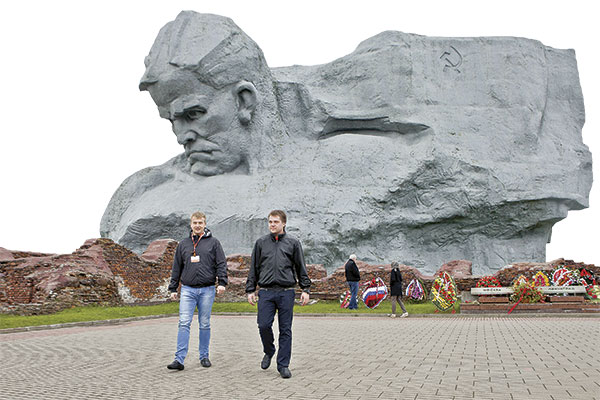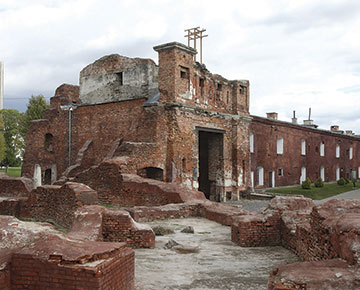
The Director of Brest Hero-Fortress Memorial, Grigory Bysyuk, tells us about the life of the fortress, its difficulties, and if there are any mysteries in its history.
One of the grandest projects of recent years at the memorial complex is its new museum.
Yes, it’s turning out well, as various experts and visitors agree. Since last year, when it opened, over 30,000 have visited, and we’ve hosted 1,000 excursion groups. Our work of 2014 earned us a special award from the President.
Our new site is an extension of the Museum of Defence, but also shows new sides of the fortress’ history, and that of its defenders. In particular, we’re looking at juvenile prisoners and prisoners of war: a theme long ignored. After being in German captivity, many defenders of the fortress passed through our filtration camps. We’ve opened another page of history, about which we didn’t dare speak for a long time...
The museum has required major investments. Russian sponsors have rendered essential help.
Yes, Gazprom paid for the Museum of War’s Territory of Peace: 15 billion Roubles were allocated over two and a half years, for repairs. Also, utility lines were laid to supply the exhibition premises.
What other innovations have there been?
We have a new excursion, to Pogranichny Island’s Terespol Fort. About 3,000 visitors have already visited and interest is growing — not only among Brest residents, but foreign visitors.
In one interview, your predecessor, Valery Gubarenko, said that there were problems with the condition of monuments, utility lines and fortress constructions. How are things going now?
One stage of reconstruction ended in 2007, with the memorial complex brought into good condition. However, over time, new problems emerged, such as the ruined barracks of the 333rd regiment needing repair.
Serious questions arose concerning the repair of roofs at the south-western and southern barracks, as last preservation works occurred 10, 20 and, even, 30 years ago. Immediate intervention was required. The Ceremonial Square and the White Palace also await restoration, as does the bridge, which is the main access road to the central island.

Besides restoration, do you have plans to develop the memorial?
Certainly. We’d very much like to add an exhibition on the history of Brest Fortress, with a panorama, and technical novelties, as we have at the new museum. One of the most interesting sites is the V Fort, which we’d like to use to host an exhibition on the First World War, and the history of its pre-war construction.
Who are the most frequent visitors of the fortress, and where do they come from?
They come from all regions of Belarus, and many from Russia. Tourism has grown considerably since the screening of the film ‘Brest Fortress’. Last year, we received almost 400,000 visitors: more than 7,500 groups. From CIS countries, we’ve welcomed 2,660 excursion groups, and 70 from elsewhere abroad (677 people). Over 23 million visitors, from 140 countries, have come to us since our site opened. Last year, over 160,000 people visited our website.
You’re carrying out major research work too?
Our research assistants are seeking out new material in the archives, as well as working with veterans and their relatives, to create exhibitions and gain new artefacts for display. They prepare articles for the media relating to Brest Fortress, and participate in conferences across Belarus and abroad. It’s important that they continue to conduct research.
Coinciding with the 70th anniversary of the Victory, we’ve been receiving three or four letters a week from the grandchildren and great-grandchildren of former soldiers. Often, they know the surname, name, patronymic and place of service (the Fortress), so we can search our archive for information. It’s laborious but essential.
Fortress research continues. Sergey Smirnov wrote much about the site. Are there still ‘mysteries’ to be solved?
Certainly. He himself admitted as much, as did the defenders. For example, Piotr Gavrilov said that Smirnov had written a great deal but that much remained to be discovered. Gavrilov recollects a group with whom he served in defending the Eastern fort, but we have no idea which group. There were other Red Army soldiers nearby of whom we know little. Besides which, a war is never over until the last soldier is buried. We continue our excavations.

Brest Hero-Fortress Memorial, Courage Monument
Do other museums help you with your research?
Yes, and not only in Belarus. The Central Armed Forces Museum, the St. Petersburg Museum and the Kiev Museum of War have all helped us, having material on the signing of the Treaty of Brest-Litovsk in 1918.
We’ve been liaising closely with some Russian museums; in particular, we’ve been working with those in regions where our defenders lived before the war or after Victory. We’re convinced that local museums also have materials on these people. There are so many examples of co-operation. We’ve exchanged exhibitions with the Kaliningrad Museum, which also has a V fort, and have worked with the Ryazan Museum in the same way.
Do you gain new exhibits regularly?
Recently, we attended a conference in Russia and brought back a Singer sewing machine, owned by Master Sergeant Nozdrin’s family. He was a defender of Brest Fortress, and went missing at the beginning of the war. However, his wife and son continued to live in Brest during the occupation. Nozdrin’s son, Dmitry Ivanovich, donated the sewing machine to us. It joins more than 87,000 exhibits. We have over 45,000 substantial items.
Recently, there’s been much talk about further development of the territory around Brest Fortress. What’s your feeling?
There are major prospects for doing so. The Development Fund of the Fortress has been created, and serious investigations carried out. We’ve received many offers, including from the Russians, the Austrians, the Dutch, and well-known people in the field of historiography.
We’ve begun work on a concept of development, focusing not only on the memorial territory, but the whole Fortress site: the western part of Kobrin Fort, and Terespol and Volyn forts.
We have two proposals: the concept of the Development Fund and that of well-known Brest architect Mikhail Gaidukovich. The first, ‘Brest 2019’, is quite well-developed, though some areas still need elaboration. Unfortunately, we yet lack a partner but there’s no rush. It’s better to choose wisely. We may need to place some remains in storage, putting as much in order as we can and including these sites within a tourist route. Time will show us where to go next.
Grigory Bysyuk
The Director of Brest Hero-Fortress Memorial:
The museum is turning out well, as various experts and visitors agree. Since last year, when it opened, over 30,000 have visited, and we’ve hosted 1,000 excursion groups. Our work of 2014 earned us a special award from the President.
By Alexander Mityukov











